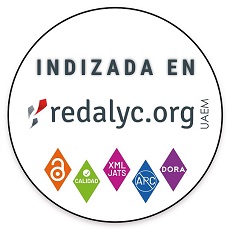Public debt in Colombia: a post-Keynesian and institutionalist analysis
Deuda pública en Colombia: un análisis post-Keynesiano e institucional
DOI:
https://doi.org/10.15446/cuad.econ.v42n88.102874Palabras clave:
Public debt, Fiscal policy, Monetary policy, Colombia, Post-Keynesian theory (en)Deuda pública, Política fiscal, Política monetaria, Colombia, teoria poskeynesiana (es)
Descargas
This article studies the institutional framework and the empirical evolution of Colombian public debt for the period 2001-2020 within a post-Keynesian approach. The objective is to render clear the potential that debt emission has as a macroeconomic policy instrument, and consequently to propose various policy routes for Colombian government. These policy routes suggest a different path than the one indicated by the orthodox economic tradition that has ruled the policy practiced in Colombia. In particular, taking into account the institutional and external limitations of fiscal policy, the revival of the ‘Development Bank’ inside the Central Bank of Colombia, and insist in and the need of cooperation and coordination of macroeconomic policies with the countries of the region are insisted.
Este artículo estudia el marco institucional y la evolución empírica de la deuda pública colombiana para el periodo 2001-2020 desde la teoría post-Keynesiana. El objetivo es hacer visible el potencial que tiene la emisión de deuda pública como política macroeconómica y consecuentemente proponer algunas rutas de política económica. Estas rutas sugieren un camino diferente al trazado por la economía ortodoxa que ha dominado en Colombia. En particular, teniendo en cuenta las limitaciones institucionales y externas que afronta el gasto público en Colombia, se considera volver a instituir el ‘Banco de Desarrollo’ como parte del Banco de la República de Colombia, e insistir en la necesidad de la cooperación y coordinación de políticas macroeconómicas con los países de la región.
Referencias
Akram, T., & Uddin, S. A.-H. (2021). The empirics of long-term Mexican Government bond yields (Working Papers, 984). Levy Economics Institution. https://www.levyinstitute.org/publications/the-empirics-of-long-term-mexican-government-bond-yields DOI: https://doi.org/10.2139/ssrn.3780186
Ángel, S. R., Castro, H. R., & Tejeiro, J. O. (2020). Multiplicadores de los impuestos y del gasto público en Colombia: aproximaciones SVAR y proyecciones locales (Borradores de Economía, 1114). Banco de la República de Colombia. https://repositorio.banrep.gov.co/handle/20.500.12134/9837
Becerra, L. A., & Ramos, J. E. (2020). El gasto público en Colombia: comparaciones internacionales, evolución y estructura. Revista de Economía Institucional, 22(42), 211-239. https://doi.org/10.18601/01245996.v22n42.09 DOI: https://doi.org/10.18601/01245996.v22n42.09
Central Bank of Colombia (2022). Statistics. https://www.banrep.gov.co/es/estadisticas
CEPAL (2022). CEPALSTAT. Retrived from: https://statistics.cepal.org/portal/cepalstat/index.html?lang=es
Cesaratto, S. (2016). The state spends first: Logic, facts, fictions, open questions. Journal of Post Keynesian Economics, 39(1), 44-71. https://doi.org/10.1080/01603477.2016.1147333 DOI: https://doi.org/10.1080/01603477.2016.1147333
Ciccone, R. (2013). Public debt and aggregate demand: Some unconventional analysis. In S. Levrero, A. Palumbo, & A. Stirati (Eds.), Sraffa and the Reconstruction of Economic Theory (vol. 2). Palgrave MacMillan. DOI: https://doi.org/10.1057/9781137319166_2
Ciccone, R. (2020). On the social irrationality of the limits of public debt. In P. d. Muro, S. Fratini, & A. Naccarato (Eds.), Economics, Policy and Law (pp. 62-88). Universitá degli Studi Roma Tre Dipartimento di Economia.
Congress of Colombia (2011) Law 1473/2011. https://www.funcionpublica.gov.co/eva/gestornormativo/norma.php?i=43236#:~:text=La%20presente%20ley%20tiene%20por,%C3%81mbito%20de%20aplicaci%C3%B3n.
Epstein, G. (2019). The institutional, empirical and policy limits of “Moder Money Theory” (Working Paper Series, 481). Political Economy Research Institute of University of Massachusetts Amherest. https://peri.umass.edu/publication/item/1159-the-institutional-empirical-and-policy-limits-of-modern-money-theory
Fullwiler, S. (2020). When the interest rate in the national debt is a policy variable (and “printing money” does not apply). Public Budgeting & Finance, 40(3), 72-94. https://doi.org/10.1111/pbaf.12249 DOI: https://doi.org/10.1111/pbaf.12249
Fullwiler, S., Felipe, J., Estrada, G., Jaber, M. H., Magadia, M. A., & Patagan, R. (2020). How ‘monetization’ reallyworks - examples from nations policy responses to COVID-19 (Working Paper Series, 627). ADB Economics. http://dx.doi.org/10.22617/WPS200368-2 DOI: https://doi.org/10.22617/WPS200368-2
Gabor, D. (2021). Revolution without revolutionaries: Interrogating the return of monetary financing. Transformative Responses to the Crisis. https://transformative-responses.org/wp-content/uploads/2021/01/TR_Report_Gabor_FINAL.pdf DOI: https://doi.org/10.31235/osf.io/ja9bk
Garbellini, N. (2016). Small fiscal multipliers do not justify austerity: A macroeconomic accounting analysis of. Journal of Economic Issues, 50(4), 1027-1044. https://doi.org/10.1080/00213624.2016.1249748 DOI: https://doi.org/10.1080/00213624.2016.1249748
Godley, W., & Lavoie, M. (2007). Fiscal policy in a stock-flow consistent (SFC) Model. Journal of Post Keynesian Economics, 30(1), 79-100. https://www.jstor.org/stable/27746787 DOI: https://doi.org/10.2753/PKE0160-3477300104
González, J. Z. (2020). Acumulación de deuda pública y política fiscal en América Latina. (F. d. México, Ed.). Investigación Económica, 79(314), 3-37. http://dx.doi.org/10.22201/fe.01851667p.2020.314.76704 DOI: https://doi.org/10.22201/fe.01851667p.2020.314.76704
Government of Colombia (2015). Decree 1068/2015. https://www.funcionpublica.gov.co/eva/gestornormativo/norma.php?i=72893
Government of Colombia (2018). Resolution 5112/2018 https://www.banrep.gov.co/sites/default/files/reglamentacion/archivos/Resolucion_5112_%202018.pdf
Griffith-Jones, S., Ocampo, J. A., Rezende, F., Schclarek, A., & Brei, M. (2018). The future of National Development Banks. In S. Griffith-Jones, & J. A. Ocampo (Eds.), The future of National Development Banks. Oxford University Pres. DOI: https://doi.org/10.1093/oso/9780198827948.003.0001
Hernández, G. (2020). Marco legal del Banco de la República. Banco de la República de Colombia.
Lavoie, M. (2013). The monetary and fiscal nexus of neo-chartalism: A friendly critique. Journal of Economic Issues, 47(1), 1-32. https://doi.org/10.2753/JEI0021-3624470101 DOI: https://doi.org/10.2753/JEI0021-3624470101
Lavoie, M. (2014). Post-Keynesian economics: New fundations. Edward Elgar. DOI: https://doi.org/10.4337/9781783475827
Lerner, A. (1943). Functional finance and the federal debt. Social Research, 10(1), 38-51. https://www.jstor.org/stable/40981939
MACROTRENDS. (2022). Brent crude oil price. https://www.macrotrends.net/2480/brent-crude-oil-prices-10-year-daily-chart
Ministry of Finance and Public Credit of Colombia. (2015). Informe de cumplimiento de la regla fiscal en 2014.
Ministry of Finance and Public Credit of Colombia. (2018). Estrategia de gestión de la deuda de mediano plazo 2018-2022. https://www.minhacienda.gov.co/webcenter/ShowProperty?nodeId=/ConexionContent/WCC_CLUSTER-111569
Ministry of Finance and Public Credit of Colombia. (2019). Programa de préstamo temporal de títulos a los creadores de mercado con títulos de tesorería TES. https://www.minhacienda.gov.co/webcenter/ShowProperty?nodeId=%2FConexionContent%2FWCC_CLUSTER-120913%2F%2FidcPrimaryFile&revision=latestreleased
Ministry of Finance and Public Credit of Colombia (2013; 2014; 2015; 2016; 2017; 2018; 2019; 2020). Informe de cumplimiento de la regla fiscal.
Ministry of Finance and Public Credit of Colombia (2022). Statistics. https://www.minhacienda.gov.co/webcenter/portal/Estadisticas
Ocampo, J. A. (2021). La dominancia de la balanza de pagos y sus implicaciones para la política económica. In J. A. Ocampo, & J. Malagón (Eds.), Macroeconomía bajo la balanza de pagos (pp. 1-19). Banco de la República de Colombia. DOI: https://doi.org/10.32468/Ebook.664-417-4
Ocampo, J. A., & Arias, P. (2018). Colombia’s system of national development. In S. Grieffith-Jones, & J. A. Ocampo (Eds.), The future of national development banks. Oxford University Press. DOI: https://doi.org/10.1093/oso/9780198827948.003.0007
Ocampo, J. A., Orbegozo, G., & Villamizar, M. (2020). Post-graduation from the original sin problem: The effects of market participation on sovereign debt markets in Colombia. 1113. https://repositorio.banrep.gov.co/handle/20.500.12134/9835
OECD. (2022). General government debt. https://data.oecd.org/gga/general-government-debt.htm
Osorio, D., & Sarmiento, M. (2018). El mecanismo de operación de la políica monetaria del Banco de la República: subasta vs. ventanilla (Reportes del Emisor). Banco de la República de Colombia.
Pabón, Ó., & Bedoya, J. G. (2016). Regla de Taylor en Colombia: ¿variante a través del tiempo? Ensayos de Economía, 26(49), 113-136. https://doi.org/10.15446/ede.v26n49.63819 DOI: https://doi.org/10.15446/ede.v26n49.63819
Paula, L. F., Fritz, B., & Prates, D. (2017). Keynes at the Periphery: Currency hierarchy and challanges for economic policy in emerging economies. Journal of Post Keynesian Economics, 40(2), 183-202. https://doi.org/0.1080/01603477.2016.1252267 DOI: https://doi.org/10.1080/01603477.2016.1252267
Prates, D. (2020). Beyond modern monetary theory: A Post-Keynesian approach to the currency hierarchy, monetary sovereignty, and policy space. Review of Keynesian Economics, 8(4), 494-511. https://doi.org/10.4337/roke.2020.04.03 DOI: https://doi.org/10.4337/roke.2020.04.03
Prebisch, R. (2012 [1949]). El desarrollo económico de la América Latina y algunos de sus principales problemas. CEPAL. https://repositorio.cepal.org/handle/11362/40010
Restrepo, J. (2020). How big are fiscal multipliers in Latin America? (Working Papers, 17). IMF. https://www.imf.org/en/Publications/WP/Issues/2020/01/31/How-Big-are-Fiscal-Multipliers-in-Latin-America-48959 DOI: https://doi.org/10.5089/9781513526836.001
Rey, H. (2015). Dilemma not trilemma: The global financial cycle and monetary policy independence (Working Papers Series, 21162). NBER. https://www.nber.org/papers/w21162 DOI: https://doi.org/10.3386/w21162
Rodríguez, C. (2021). Financiarización de la política fiscal y su impacto sobre la deuda pública de Colombia entre 1996-2015. Cuadernos de Economía, 40(82), 253-282. https://doi.org/10.15446/cuad.econ.v40n82.80197 DOI: https://doi.org/10.15446/cuadecon.v40n82.80197
Romero, J. V., Herrera, H. V., Cardozo, P., & Murcia, A. (2020). Effects of foreign participation in the Colombian local public debt market on domestic financial conditions (Cuadernos de Economía, 1115). Banco de la República. https://www.banrep.gov.co/en/effects-foreign-participation-colombian-local-public-debt-market-domestic-financial-conditions DOI: https://doi.org/10.32468/be.1115
Tejada, D. G., Ángel, S. R., & Castro, H. R. (2021). Déficit Gemelos en Colombia: ¿Existen?¿Qué casua qué?¿Cuál es el grado de impacto? (Borradores de Economía, 1186). Banco de la República. https://repositorio.banrep.gov.co/handle/20.500.12134/10250
Thirlwall, A. (2011). Balance of payments constrained growth models: History and overview. PSL Quarterly Review, 64(259), 307-351. http://ssrn.com/abstract=2049740
Tymoigne, E. (2020). Monetary sovereignty: Nature, Implementation, and implications. Public Financial Publications, 1-23. https://doi.org/10.1111/pbaf.12265 DOI: https://doi.org/10.1111/pbaf.12265
Vernengo, M., & Caldentey, E. P. (2020). Modern money theory in the tropics: Functional finance in developing countries. Challenge, 63(6), 332-348. https://doi.org/10.1080/05775132.2020.1747729 DOI: https://doi.org/10.1080/05775132.2020.1747729
Villa, E., Misas, M., & Giraldo, A. (2014). Inflation targeting and an optimal Taylor rule for an open economy: Evidence for Colombia 1990- 2011. Latin American Journal of Economics, 51(1), 41-83. https://www.jstor.org/stable/23729155 DOI: https://doi.org/10.7764/LAJE.51.1.41
Cómo citar
APA
ACM
ACS
ABNT
Chicago
Harvard
IEEE
MLA
Turabian
Vancouver
Descargar cita
Licencia
LicenciaCuadernos de Economía a través de la División de Bibliotecas de la Universidad Nacional de Colombia promueve y garantiza el acceso abierto de todos sus contenidos. Los artículos publicados por la revista se encuentran disponibles globalmente con acceso abierto y licenciados bajo los términos de Creative Commons Atribución-No_Comercial-Sin_Derivadas 4.0 Internacional (CC BY-NC-ND 4.0), lo que implica lo siguiente:





















